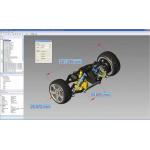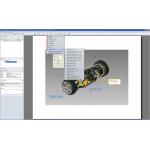Latest News
December 4, 2001
By David Cohn
3.Over the years, Autodesk has come up with several different methods for sharing CAD data in a secure, compact format, finally settling on DWF. When first introduced, DWF contained only 2D data and the acronym stood for Drawing Web Format. In the fall of 2003, Autodesk updated DWF so that it could also support 3D. In conjunction with that change, the company began referring to DWF as Design Web Format.
Then, simultaneous with the release of AutoCAD 2005, the company introduced Autodesk DWF Composer, a low-cost application that let users open and view DWF files; annotate those files using a variety of text, comment, and drawing tools; and then save (republish) the marked-up DWF file. Users could then send those marked-up files back to AutoCAD, where the annotations could be viewed in the context of the original AutoCAD drawing.When DWF contained 2D data, the DWF file was the electronic equivalent of a printed document, very similar to a PDF file, and you could use DWF Composer to view and annotate those documents. When the DWF file contained 3D data, however, DWF Composer became just a viewer. You could pan, zoom, and spin the 3D model, and turn individual parts of an assembly on and off, but the program had none of the measure, markup, and section capabilities found in other 3D viewers. Autodesk DWF Composer 2.0 begins to change that.
The first difference users will notice is the revised Navigator panel along the left side of the DWF Composer window. Gone is the tabbed interface, replaced by a series of rollup palettes that allow you to access sheets, bookmarked items, 3D models, views, layers, and properties. When you open a 2D DWF file, the panel contains a Content Browser that displays all the sheets in a multisheet DWF file as either a list or a series of thumbnails. If you open a 3D DWF file, this area is replaced by a Model palette that shows the assembly’s parts in a hierarchical tree. Views and Layers palettes replace the dialog boxes used in the previous version to switch to named views or turn layers on and off, respectively.
When you select an assembly or part in the Model palette, DWF Composer now displays its physical properties—such as area, center of gravity, density, mass, material, and volume—in the Properties palette. Beginning with AutoCAD 2006, DWF files can now include blocks. If you select a block within a DWF file, all of its attribute data displays within the Properties palette.
New 3D DWF Capabilities: Measure & Markup
When working with 2D DWF files, other changes in the program are quite subtle. But when you open a 3D DWF file, the program’s new capabilities are readily apparent. Controls for changing 3D views—altering view orientation, changing shading, and switching to a perspective view—are now organized in a single toolbar flyout. Adjacent to this are two new buttons: Measure and 3D Markup.
|
|
| Figure 1: DWF Composer 2 lets users measure 3D objects and view physical properties within an assembly. |
Measure lets you gauge distances between points, edges, center points, or any combination of these; the angle between edges; and the radii of arcs and circles (see Figure 1, right). When you click this button, a Measure dialog box displays so that you can select the units of measurement. Then, as you move the cursor over the model, DWF Composer highlights any points or edges. You simply click to select what’s highlighted. You can then drag and click where you want to place the measurement. The resulting measurement also displays within the Measure dialog box.
If you change the view orientation, the measurement disappears, but as long as the measurement is displayed, you can print the DWF file with the measurement. In order to retain a measurement or otherwise mark up a 3D DWF file, you must first create a flat view of the 3D model. That’s where the 3D Markup button comes into play. Clicking that button immediately saves the current view of the 3D model and opens it as a 2D view in a second copy of DWF Composer. You can then use any of the 2D markup tools to annotate that view of the 3D model.
A new Snapshot button then lets you capture additional 3D views. When you click this button, a capture window appears. You can then switch back to the copy of DWF Composer displaying the 3D model, reorient the model as necessary, reposition and resize the capture window, and then click the Snapshot button in the capture window. DWF Composer immediately adds the captured 2D view to the same 2D DWF file. You can also use this screen capture capability to capture any portion of your screen—including images of word processor documents, for example—and bring it into DWF Composer.
New 2D Features As Well
Autodesk has also made some very nice changes to the 2D environment. DWF Composer 1.0 included markup tools such as lines, polylines, rectangles, and ellipses, as well as rubber stamps such as Approved, Preliminary, and Final. But you could not customize any of these tools or add your own. That omission has now been addressed. Users can import any DWF file containing 2D drawings, images, or text and add it as a symbol; it then appears in the Stamps and Symbols drop-down list.
Since DWF files can now include block information, if the file being imported as a symbol includes blocks, individual blocks can be imported as separate symbols, which then appear within a symbol catalog. You can then insert the individual blocks as symbols. Once a symbol has been placed on a sheet in the DWF file, it appears in the DWF Composer Markup palette for tracking. If you subsequently open the marked up DWF file in AutoCAD (using that program’s Markup Set Manager tool), the symbols all appear as part of the DWF file.
|
|
| Figure 2: After capturing a 2D image of a 3D model, you can use Composer’s standard markup tools or import any DWF file as a custom markup. The markup status is now color-coded. |
Other enhancements include color-coding of markup status (see Figure 2, right). DWF Composer tracks the history of each markup, along with its creator and status. Now, when you change the status of a markup—from For Review to Done for example—its symbol in the Markups palette, as well as a colored halo around the markup within the sheet, changes as well.
Getting Good
The DWF Composer 2.0 CD also includes DWF Writer, a Windows system driver that lets you create DWF files as a print function from any application; DWG Viewer, a program for viewing and plotting DWG and DXF files; and Autodesk Inventor View, a new application for viewing and printing Autodesk Inventor part, assembly, and drawing files.
The most recent releases of Autodesk’s products also forge much closer ties to DWF. All AutoCAD-based products can now publish both 2D and 3D DWF files and view markups added in DWF Composer. Inventor can also publish both 2D and 3D DWF files, but is not yet able to display markups.
DWF Composer still lacks the true 3D markup and sectioning capabilities found in some other 3D viewers, but the new capabilities go a long way toward making DWF Composer as valuable when working with 3D as it already is in a 2D environment.
David Cohn is a computer consultant and technical writer based in Bellingham, WA. He’s a Contributing Editor to Desktop Engineering, the Editor-in-Chief of Engineering Automation Report and CADCAMNet published by Cyon Research, and the author of more than a dozen books. You can contact David through his website or click here to send him an e-mail about this article.
Subscribe to our FREE magazine, FREE email newsletters or both!
Latest News
About the Author
David Cohn is a consultant and technical writer based in Bellingham, WA, and has been benchmarking PCs since 1984. He is a Contributing Editor to Digital Engineering, the former senior content manager at 4D Technologies, and the author of more than a dozen books. Email at [email protected] or visit his website at www.dscohn.com.
Follow DE







